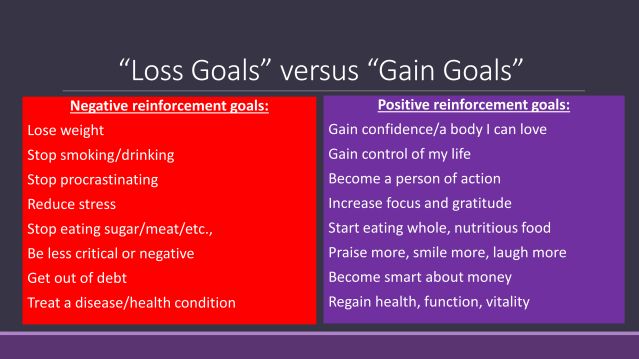Motivation
The Positive Reinforcement Approach to Resolutions
You can enhance your goal-setting with this reinforcement strategy.
Posted December 22, 2023 Reviewed by Ray Parker
Key points
- New Year's Resolutions are dominated by "loss goals" focused on reducing negative qualities.
- Research shows that positive reinforcement is superior to negative reinforcement for behavior change.
- Any "loss goal" can be reframed into a "gain goal" to introduce positive reinforcement for greater success.
Ask a group of experts why it is hard to lose weight, and you'll likely hear some of the following answers:
- Diets don't work because people can't stick to them.
- Our metabolism fights back, causing hunger and weight regain.
- Modern food is addictive.
- People don't have time to exercise, and our lifestyles are too sedentary.
Sound familiar? Yet even among a crowd of educated health professionals, you'll rarely hear what may be one of the most important weight loss barriers of all: It is a loss-framed goal.
As decades of behavioral research make clear, goals that focus on losing things we dislike don't work, as well as goals that focus on gaining things we desire1.
In this post, we'll explore part of the psychology behind why "loss goals," such as weight loss, pain reduction, procrastination, and smoking cessation, so commonly fail and how we can reframe our self-improvement efforts into "gain goals" with a greater potential for success.
A primer on positive and negative reinforcement
If you want to improve your quality of life in 2024, there are two proven behavior strategies through which you can frame and motivate your goals. These strategies are negative reinforcement and positive reinforcement.
- Negative reinforcement goals (loss goals) motivate us through the desire to subtract something unwanted. Ridding ourselves of debt, physical or mental health conditions, excess weight, and habits, such as smoking and procrastination, are common examples of loss goals (see Figure 1 below for others) inspired by a negative reinforcement approach.
- Positive reinforcement goals (gain goals) refer to goals where we are motivated by adding something desirable. Improving fitness and function, better relationships and self-esteem, new experiences and memories, greater freedom, more love, and many others are goals motivated by a positive reinforcement approach.
As shown in Figure 1 below, nearly any goal or New Year's resolution can be approached with either a positive or negative reinforcement strategy. However, rather than realizing that we have an essential choice between these two options, we often default to how other people approach the same goal.
If you want better results than most other people, stop doing that.

Why your choice of reinforcement approach matters
If both negative and positive reinforcement work as goal motivation strategies, why not simply do whichever is easiest or most popular? Why should you and I make the deliberate effort to frame our current and future goals using a positive reinforcement approach instead of a negative reinforcement approach? Let's use an example to illustrate the difference.
The day is January 1, 2024. Two people purchase home exercise equipment to begin a regular workout habit for the new year. The first person is motivated to exercise by their desire to lose weight and feel less self-conscious (i.e., loss goals fueled by negative reinforcement).
The second person is motivated to exercise by their desire to have a more adventurous lifestyle and feel more confident (i.e., gain goals inspired by positive reinforcement).
Although the goals and methods of these two people may seem similar on the surface, their underlying psychologies are different, with potentially profound consequences.
For example, when the first person exercises, they probably think about parts of themselves and their lives that they strongly dislike. Behaviorally, they probably weigh themselves after every workout and scrutinize their body in the mirror for the features they want to eliminate. Importantly, each time they exercise, they unintentionally pair their negative thoughts and emotions about their body and weight with exercising.
Over time, through the process of conditioning, this person (like millions of Americans) may come to "hate" exercise because of its repeated pairing with negative internal and external feelings and experiences. For them, exercise has now become a trigger for feelings such as guilt, shame, and embarrassment instead of being a healthy and empowering behavior. Tragically, this conditioning pattern often begins as early as childhood.
Now consider the mental and emotional experiences of person two. They engage in the same exercise program and focus on personal benefits and improvements. They are more likely to measure their progress by gains in fitness, energy levels, body composition, strength, flexibility, and consistency rather than by numbers on the scale.
And when they look in the mirror, their eyes are more likely to scan for signs of physical progress, such as muscle definition, than for evidence of physical deficits. Over time, this positive reinforcement approach promotes a positive psychology about exercise, mentally linking the experience of physical activity to internal and external rewards instead of punitive and recurring reminders of problems.
Putting the positive reinforcement approach into practice
Psychologists such as Abraham Maslow theorized that human beings are inherently growth-oriented organisms2. He believed we are born with an instinctive sense of our possibilities and a lifelong motivation to fulfill our potential.
Maslow also argued that human unhappiness, stress, and mental illness often arose not from problems but from suppression of our native drive to grow towards self-actualized versions of ourselves.
Maslow's early 20th-century theory of motivation aligns with recent research identifying intrinsic (internal) motivation as a natural human tendency towards learning and improvement and a key factor in successful goal achievement3.
The positive reinforcement approach to goal setting described here represents a practical method for channeling our internal instincts for growth into tangible quality-of-life changes. For instance:
- Stop losing weight. Start gaining life and vitality.
- Stop focusing on problems and start focusing on solutions.
- Instead of the negatives you're trying to eliminate, focus on the positive experiences, feelings, and outcomes you're vested in obtaining.
Not only will this positive reinforcement approach to your goals increase your chances of success, but it can emotionally transform your journey.
References
1. Hattie, J., & Timperley, H. (2007). The Power of Feedback. Review of Educational Research, 77(1), 81-112. https://doi.org/10.3102/003465430298487
2. Maslow, A.H. (1943). “A Theory of Human Motivation”. In Psychological Review, 50 (4), 430-437.
3. Cerasoli CP, Nicklin JM, Ford MT. Intrinsic motivation and extrinsic incentives jointly predict performance: a 40-year meta-analysis. Psychol Bull. 2014 Jul;140(4):980-1008. doi: 10.1037/a0035661.




